Australia in the Great War
review by Christina Spittel
Charles Bean’s vision of the Australian War Memorial as an institution that would combine commemoration with historical understanding and research, was a stroke of ingenius foresight. Interpretive centres now sit alongside many of the commemorative sites on the former battlefields of the First World War, and some of the large Australian state memorials have added exhibition galleries in an effort to explain themselves to visitors for whom the war they were set up to commemorate is increasingly remote. In this busy landscape, the Australian War Memorial shoulders a special responsibility and mighty task as the custodian of the ‘National Collection’. Its new permanent First World War galleries produce an official history in objects, paintings and documents, for generations of Australians who have grown up with Anzac’s myths and legends, but without a direct experience of that or, indeed, any other war, and also for overseas visitors, who come to see one of the nation’s major tourist attractions.
Bean’s brief remains as inspired as it is demanding. The relationship between memory and history can be prickly, and the new galleries don’t always succeed in keeping the two in a productive tension. Nor does the Australian War Memorial take its visitors to the cutting edge of new research (much of which, we should add, is funded by Australian taxpayers). For all its sleek and shiny new looks, this new permanent exhibition does not offer any genuinely new perspectives.
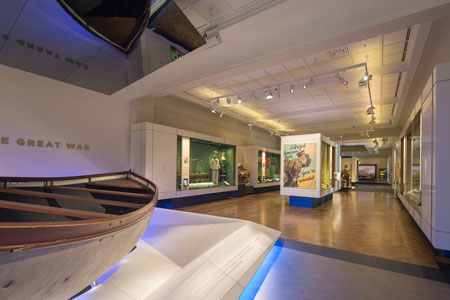
Australian War Memorial
The title of the new gallery, Australia in the Great War, is misleading: the exhibition is not about Australia at all, even though a panel in the middle of it explains that, ‘The war demanded a united national effort, but at the same time it opened up social divisions … The whole country was affected by the war’. Scholars have insisted on this view for some time, emphasising that to understand this first ‘total war’, we need a holistic approach that brings together military, social, cultural and economic historians. The new First World War galleries at the Imperial War Museum, London, show just how compellingly and elegantly this can be done. They announce at the outset that, ‘In Britain, everyone was affected by the Great War, whether they were fighting, or on the home front’.
It would have paid for the War Memorial to take a leaf from its sister institution, not least because it claims to be, as Brendan Nelson put it in his speech during the elaborate opening ceremony in February 2015, an institution that represents ‘who we were and who we are. Facing new and uncertain horizons, it is also a reminder of the truths by which we live, how we relate to one another as Australians and see our place in the world’. Instead, the Memorial’s galleries exclude the majority of Australians who experienced the war, narrating it as a string of battles, in chronological order, from early engagements in the Pacific to the Western Front, via Gallipoli and the Middle East, leaving little room for those back home.
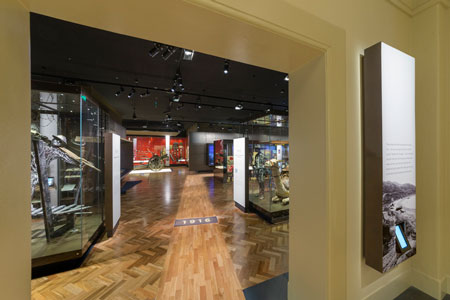
Australian War Memorial
While the Imperial War Museum collaborated with postgraduate researchers and an advisory board comprising leading British scholars in developing its new First World War exhibitions, Nelson’s opening speech only acknowledges the work of a single historian on the project team: Peter Burness, one of the Australian War Memorial’s longest serving and most experienced staff members, whose expertise shines through what is, by any measure, an authoritative presentation. Eminent historian Joan Beaumont, whose Broken Nation: Australians in the Great War won the 2014 Prime Minister’s Literary Award (Australian History), was not consulted, even though she works a stone’s throw away at the Australian National University; nor it would seem, was any other academic historian (even though the War Memorial’s Military History section is impressively networked).
Nevertheless, the exhibition gets off to a strong start: instead of finding its protagonists at Gallipoli without explaining how they got there, the initial exhibits briefly retrace how the conflict started and why Australia joined in. Once the narrative reaches Anzac, there are some nice moves to unravel at least some of the threads of what is now Australia’s most cherished myth. Thus, a display of an Indian 10-pounder mountain gun is accompanied by an explanation that (far from being natural soldiers) the Anzacs found ‘being under artillery fire … a new and disturbing experience. Birdwood feared “they were being demoralised by shrapnel fire to which they have been subjected all day”’. To travellers today, the Gallipoli peninsula presents itself as stunningly beautiful, and so the exhibition team does well to describe the 1915 experience as harrowing: ‘The ordeal of “hanging on”, living amid filth and sickness, disease and death, while constantly under threat of enemy fire, was sometimes worse than battle’. For those keen to explore further, iPads supply information about the objects on display, such as the identity disc of Colonel Antill, which serves as a hook to correct one of the lasting impressions left by Peter Weir’s 1981 film Gallipoli – that the real enemies of the Australians at the Nek were the British: tea-drinking, uncaring, incompetent.
While the exhibition is focused squarely on its Australian protagonists, a small list of casualty figures opens up a broader view of the Gallipoli campaign, reminding visitors of the exorbitant losses sustained by the Ottoman Empire (misleadingly but conveniently listed as ‘Turkey’) and Britain in particular. I can’t help drawing a connection between these figures and a particularly moving document – one of the dreaded telegrams – displayed in a glass case: on 21 June 1915, a few short lines notified Jane Allen of Heywood, Victoria, that her son was missing in action. William, the caption tells us, was killed on 25 April, but his mother kept hoping that he was alive, somewhere, in captivity.
As I walk around the galleries I’m held up a number of times. The narrow spaces crowd easily, especially during guided tours, but nowhere is my experience drowned out by an excessive use of special effects. No poppies are projected onto the walls, and Charles Webster Gilbert’s bronze Stretcher-Bearers, I notice with relief, have not been made to recite poetry.
The new exhibition design at the Imperial War Museum mimics stylised trenches, guiding visitors through a maze of dark, charcoal stone, sometimes complete with quotations and in-built seating, to culminate in a rather mythical (OH&S approved) ‘trench experience’, complete with shadowy silhouettes, and the sounds of voices, gunfire and rain. The Memorial has resisted such simulations, and its exhibition designers – Cunningham Martyn – have responded actively to its brief.
Old-time favourites with visitors, the dioramas on display have been beautifully restored, although, someone found it necessary to animate the Mont St Quentin diorama with a filmic backdrop that shows smoke emanating from a shell burst. Conceived as works of art, the dioramas were always meant to move, as well as educate. The iPad that sits next to the Lone Pine diorama tells me how overpowering this model was in the 1930s, when it drove a man into a panic: ‘I’ve got to get out. It’s too much for me. My pal was killed there beside me’. I wonder what this returned man would have made of the decision to add ‘immersive soundscapes’ here and elsewhere – a mix of gunfire, voices and weather, all muffled, so as not to be obtrusive. These imagined sounds remind me of elevator music. Ambient, but non-threatening, they put a safe distance between me and the sheer terror exercised by the noise of the frontline.
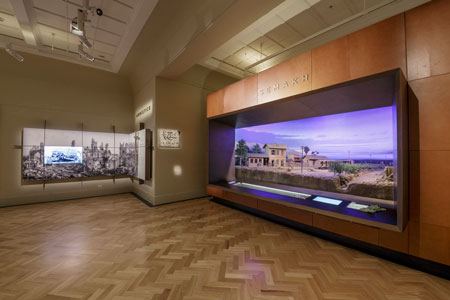
Australian War Memorial
Originally, Bean envisaged that the dioramas would be accompanied by elaborate (three-dimensional) maps, ‘plan models’, as he called them, but these bulky, impractical things were discarded some time ago, and the Memorial has not found a suitable replacement. While a large interactive display helps visitors understand the geography of Gallipoli, some of the places on the Western Front remain mythical – the display case on the Hindenburg Line would have been improved by a good map.
The exhibition contains a multiplicity of voices and stories, including the small engraved wristwatch that allowed Private Albert Howes, initially lost without a trace on the Western Front on 29 August 1916, to be identified at Pozières in 1925, and the big, overbearing stretcher bearer who has replaced Peter Corlett’s more passively suffering Man in the Mud diorama. Now, the stylised man stands up on a duckboard, bearing his stretcher like a cross, reminding me of the moment when Peter Weir’s Archie, also unarmed, runs into a hail of bullets in the closing scene of Gallipoli. Several photographic displays, with accompanying iPads, offer glimpses of different war experiences. The panel explaining the complex conscription debates admits that: ‘clearly the opinions and motives of the troops were as diverse as those of the general population’. But the focus is generally, even unremittingly, on the common experiences of men in uniform and, overwhelmingly, of infantrymen.
In his role as education minister, Brendan Nelson warned Australians that, ‘if we lose sight of what Simpson and the donkey represent, then we will lose our direction as a country’. More recently, he has been adamant that a visit to the Australian War Memorial is every citizen’s duty: ‘Those Australians who are able,’ he told the ABC, ‘have not only an opportunity but a responsibility to see the First World War galleries.’ Occasionally, his team is a little too eager, too teacherly, in its attempts to satisfy the perceived need for moral lessons. The shiny ‘Gallantry in action’ display is a case in point. Here, medals are interpreted to showcase the attributes illustrated in the Hall of Memory’s stained-glass windows: gallantry and coolness, all in upper-case, are thus on display. Captain Mersey Hammond, ‘a remarkable and fearless leader’, embodies INSPIRATION. Sister Rachel Pratt is a model of DEVOTION for continuing to attend to her patients during an air raid in a Casualty Clearing Station, despite being severely injured herself. And then there is the SELFLESSNESS of Corporal Ernie Corey, a stretcher bearer and the ‘only man in the British Empire ever to be awarded the Military Medal four times’. Such hagiography turns complex individuals into cardboard figures. I can’t help but wonder if the memory of the nurse and the stretcher bearer, in particular, might not have been better served if someone had taken a genuine interest in their work.
But the new galleries are very reluctant to engage with damage and destruction. A display case on the medical services on Gallipoli shows us Simpson, his donkey and a little nurse doll, and gives no indication of what the wounds received in battle were like. The doll was sent home by sister Nellie Morrice to her four-year-old niece – an appropriate gift for a toddler, but, surely, the average visitor to the Memorial is significantly older than that, and can stomach a little more detail about what Nellie really did in hospitals in Egypt and later on Lemnos? Much of this has to be guessed, unfortunately.
Objects shot through with bullets do provide some clues. An Australian bayonet suggests the wounds that it might inflict. A badly dented, rusty gun bears testimony to the sheer destructiveness of modern artillery. The First World War saw significant advances in medicine, but the only artificial leg on display is Harvey Blackburn’s, a veteran of the Boer War, who was ‘desperate to serve’. A panel in the 1916 room tells me that, before his call-up, Blackburn lost half his leg in a train accident, but hobbled to the Western Front regardless and kept going until 1918. The same room also contains an X-ray of a torso riddled with shrapnel (‘a grisly memento’). This is, however, a rare find. Some of the figures that dot the dioramas are clearly dead, but they are all whole, intact. (Perhaps they had to be, out of sensitivity for the men’s next-of-kin in the audiences of the interwar period.) And yet, an exhibit shows that the men who collected many of the items, often straight off the battlefields, wanted the destruction to be acknowledged: the small space that recollects the Australia War Memorial’s beginnings on the Western Front contains a shrapnel-damaged rifle oil bottle, complete with an original label, issued by the Australian War Records Section. In August 1918, HH Green of the 41st Battalion donated the item and indicated its purpose in black ink: ‘This bottle shows the effect of shrapnel.’
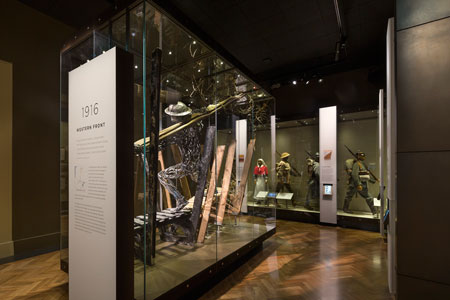
Australian War Memorial
The small, darkened room that follows on from the moment of victory in the 1918 gallery makes the only concerted effort to confront the cost of war in some detail, but this is strangely disembodied. Visitors read of George Bingley’s ‘bittersweet reunion’ with his family on his return. Two of his brothers had not survived the Western Front and, in his absence, his fiancée had married another man. George never recovered. ‘He never married and he never returned to his pre-war occupation as a motor-body builder.’ Corporal Harry Thorpe’s weathered headstone, donated when in need of replacement, stands in for ‘the distant dead’: ‘Thorpe was born at the Lake Tyers Aboriginal Mission Station, Victoria, and enlisted in the AIF in 1916.’ But Harry is distant in another way, too. Like that of other Indigenous Australian men, his story is clipped short. I learn nothing of Harry’s pre-war life and how this might have shaped his experience. A short paragraph on ‘mental and physical scars’ acknowledges that ‘life was difficult for these men and women’. Charlie Stevens’s wheelchair represents the limbless soldier (‘In later years, he enjoyed taking the aging wheelchair for a spin’). Wedged into a corner of the room is a glass case with photos of facially disfigured soldiers, a notable first for the Memorial. Here too, the Imperial War Museum is bolder. It shows a short film from 1918 featuring shell-shocked men and, alongside its own collection of harrowing images of facial disfigurement, it tries to get its visitors thinking about how these men might have lived with their wounds by including in the display the masks they wore and the drinking straws they were forced to use.
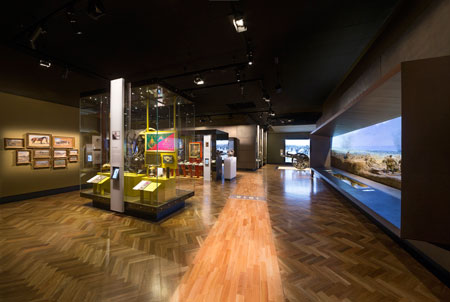
Australian War Memorial
‘It is a great milestone, not only for the Australian War Memorial – but for Australia,’ Brendan Nelson proclaimed at the opening ceremony of the new galleries. And indeed, having begun with the ambitions of imperial statesmen, portrayed as large, wiry mannequins in elaborate old uniforms, the War Memorial concludes the new exhibition’s narrative arc in a brightly lit room of proud, defiant nationalism: ‘Every nation has its story,’ I am told, ‘This is ours’. The need for royal endorsement, sourced from a speech by Queen Elizabeth, delivered in 1954, and a copy of the plaque given to Prince William and Princess Kate in 2014, is strangely at odds with Lee Kernaghan singing ‘Waltzing Matilda’. But I’m more concerned with the exhibition’s bizarre efforts to put a lid on the past in this way, to close it off to interrogation and investigation, to pretend that it exists as one single story, with one fixed meaning.
When the War Memorial last overhauled its First World War galleries in the 1980s, it invited as many veterans of the conflict as it could locate. Some accepted the invitation to the opening and died just before they could board the plane, but 240 Gallipoli men, all in their 80s and 90s, made their way to Canberra in August 1984. Not all of them liked what they saw – a cultural institution that was reinventing and rejuvenating itself, staffed by museum professionals and historians, rather than those who had seen war. At the centenary of their war, not one veteran survives. With this comes a responsibility, I think, not to forget that they were real people, if only for the simple reason that we keep sending men and women to war. These men and women deserve to be reassured that we will grapple with their wars in all their complexity. How would Charles Bean have put it? ‘In your hands, Australians!’
Christina Spittel teaches English in the School of Humanities and Social Sciences, UNSW Canberra, and researches the intersections between literature, history, memory, and politics.
| Exhibition: | Australia in the Great War |
| Institution: | Australian War Memorial |
| Project manager: | Katherine McMahon, FWW Project Director, Australian War Memorial |
| Curatorial team: | Nick Fletcher (concept leader); Peter Burness (concept leader – story); Danielle Cassar (curator); Kate Morschel, Jen Selby and Luke Diggins (assistant curators); Laura Webster (curator – art) |
| Exhibition design: | Cunningham Martyn Design (CMD) |
| Graphic design: | Beattie Vass Design (BVD) [sub-contracted to CMD] |
| Venue and exhibitiondates: |
A permanent exhibition on display at the Australian War Memorial, Canberra, from 1 December 2014 |
| Website: | www.awm.gov.au/visit/first-world-war-galleries/ |
| Gallery size: | 1740 square metres |
